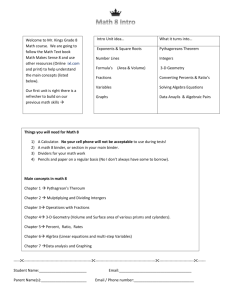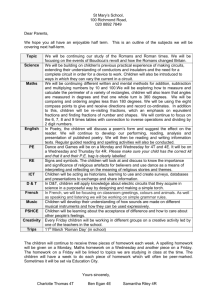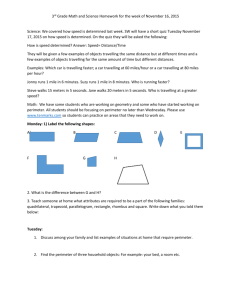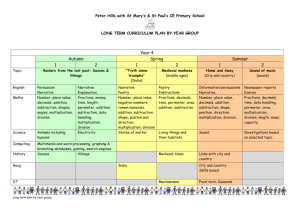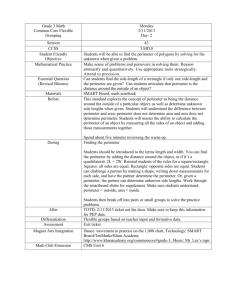Maths Unit 8 Information
advertisement
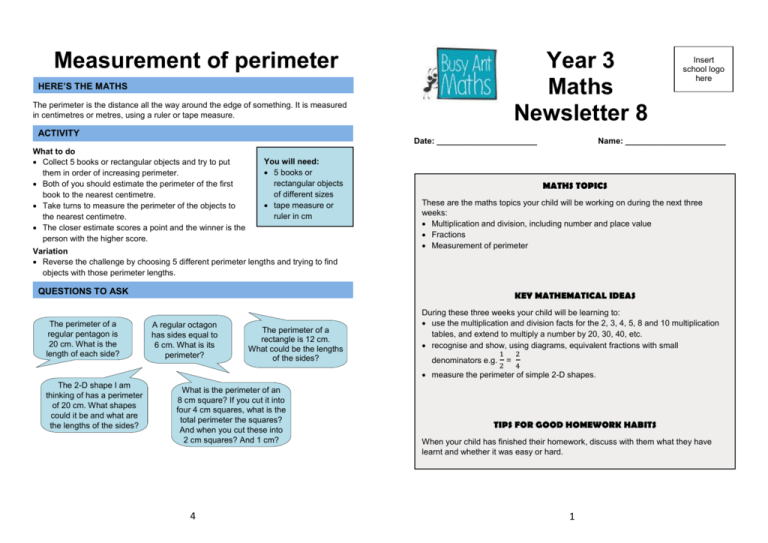
Measurement of perimeter Year 3 Maths Newsletter 8 HERE’S THE MATHS The perimeter is the distance all the way around the edge of something. It is measured in centimetres or metres, using a ruler or tape measure. ACTIVITY Date: ______________________ What to do Collect 5 books or rectangular objects and try to put them in order of increasing perimeter. Both of you should estimate the perimeter of the first book to the nearest centimetre. Take turns to measure the perimeter of the objects to the nearest centimetre. The closer estimate scores a point and the winner is the person with the higher score. You will need: 5 books or rectangular objects of different sizes tape measure or ruler in cm Variation Reverse the challenge by choosing 5 different perimeter lengths and trying to find objects with those perimeter lengths. Name: ______________________ MATHS TOPICS These are the maths topics your child will be working on during the next three weeks: Multiplication and division, including number and place value Fractions Measurement of perimeter QUESTIONS TO ASK The perimeter of a regular pentagon is 20 cm. What is the length of each side? Insert school logo here KEY MATHEMATICAL IDEAS A regular octagon has sides equal to 6 cm. What is its perimeter? The perimeter of a rectangle is 12 cm. What could be the lengths of the sides? During these three weeks your child will be learning to: use the multiplication and division facts for the 2, 3, 4, 5, 8 and 10 multiplication tables, and extend to multiply a number by 20, 30, 40, etc. recognise and show, using diagrams, equivalent fractions with small denominators e.g. 1 2 = 2 4 measure the perimeter of simple 2-D shapes. The 2-D shape I am thinking of has a perimeter of 20 cm. What shapes could it be and what are the lengths of the sides? What is the perimeter of an 8 cm square? If you cut it into four 4 cm squares, what is the total perimeter the squares? And when you cut these into 2 cm squares? And 1 cm? And 1 cm? 4 TIPS FOR GOOD HOMEWORK HABITS When your child has finished their homework, discuss with them what they have learnt and whether it was easy or hard. 1 Multiplication and division, including number and place value Equivalent fractions have the same value, e.g. and 3 5 What to do Place the cards face down and decide on a time to You will need: play, e.g. 3 minutes. 5 cards with 20 x, Start the timer, ask your child to pick one card and say 30 x, 40 x, 50 × and that table up to 12 times. 80 × written on them Choose another card and continue until the time runs timer (or phone with out. timer) Make a note of how many tables were completed. Take your turn. Have another go each and try to improve on your previous score. Variation Start at 12 times the number and say the multiples backwards. QUESTIONS TO ASK How many 40s in 480? Count in multiples of 100 to 1000. How many 80s in 640? = 2 4 = 4 8 . To understand equivalent . Using diagrams can help. The use of a fraction wall can also help. You can ACTIVITY What to do Circle with 1 2 3 4 1 2 3 4 1 3 1 4 1 coloured rectangle coloured 4 4 rectangle coloured 1 3 Circle with 1 circle coloured 3 3 4 2 8 4 8 2 square coloured coloured square coloured 6 8 2 6 Look at the grid with your child and agree that each row represents the same fraction expressed in a different way. Carefully cut up the grid. Turn the pieces over and muddle then up. Play the pairs game. Take turns to turn over two pieces. If they represent the same fraction, keep the pair and have another go. If they do not, turn them back over, making sure that they remain in the same positions. The winner is the player with the most pairs at the end of the game. Variation Add more cards with more challenging fractions. QUESTIONS TO ASK How do you find a quarter of a group of items? What has to be added to 5 8 to make one whole? 2 2 demonstrate fractions in a practical way when you share a bar of chocolate or a pizza (providing everyone has equal shares). 1 4 ACTIVITY 1 fractions, your child needs to have a secure grasp of unit and non-unit fractions e.g. 8 Your child has learnt the 2, 3, 4, 5, 8 and 10 times tables facts for multiplication and division. The key facts for each table are the answers to 1 times, 2 times, 5 times and 10 times the number; from these, missing values can be deduced if they cannot be instantly recalled. They know the answers to the 20 times tables by simply multiplying the answers to the 2 times table by 10, so 2, 4, 6, 8 become 20, 40, 60, 80, and similarly for the other tables. Count in multiples of 50 to 1000. HERE’S THE MATHS 1 HERE’S THE MATHS How many 30s in 120? Fractions 3 Tell me some fractions that are equivalent to 1 2 ?


